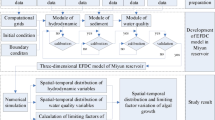Abstract
A hydrodynamic model and an aquatic ecology model of Dianshan Lake, Shanghai, were built using a hydrodynamic simulation module and the water quality simulation module of Delft3D, which is an integrated modelling suite offered by Deltares. The simulated water elevation, current velocity, and direction were validated with observed data to ensure the reliability of hydrodynamic model. The seasonal growth of different algae was analyzed with consideration of observed and historical data, as well as simulated results. In 2008, the dominant algae in Dianshan Lake was Bacillariophyta from February to March, while it was Chlorophyta from April to May, and Cyanophyta from July to August. In summer, the biomass of Cyanophyta grew quickly, reaching levels much higher than the peaks of Bacillariophyta and Chlorophyta. Algae blooms primarily occurred in the stagnation regions. This phenomenon indicates that water residence time can influence algal growth significantly. A longer water residence time was associated with higher algal growth. Two conclusions were drawn from several simulations: reducing the nutrients inflow had little effect on algal blooms in Dianshan Lake; however, increasing the discharge into Dianshan Lake could change the flow field characteristic and narrow the range of stagnation regions, resulting in inhibition of algal aggregation and propagation and a subsequent reduction in areas of high concentration algae.
Similar content being viewed by others
References
Arhonditsis G B, Brett M T. 2005. Eutrophication model for Lake Washington (USA): Part I. Model description and sensitivity analysis. Ecological Modelling, 187 (2-3): 140–178.
Bone C, Altaweel M. 2014. Modeling micro-scale ecological processes and emergent patterns of mountain pine beetle epidemics. Ecological Modelling, 289: 45–58.
Boers P C M, Van Raaphorst W, Van Der Molen D T. 1998. Phosphorus retention in sediments. Water Science and Technology, 37 (3): 31–39.
Cheng X, Li X P. 2008. 20-year variations of nutrients (N and P) and their impacts on algal growth in Lake Dianshan, China. Journal of Lake Sciences, 20 (4): 409–419. (in Chinese with English abstract)
Chung S W, Imberger J, Hipsey M R, Lee H S. 2014. The influence of physical and physiological processes on the spatial heterogeneity of a Microcystis bloom in a stratified reservoir. Ecological Modelling, 289: 133–149.
Escaravage V, Soetaert K. 1995. Secondary production of the brackish copepod communities and their contribution to the carbon fluxes in the Westerschelde estuary (The Netherlands). Hydrobiologia, 311 (1-3): 103–114.
Feng D X, Liu Y, Yu N, Chen L, Li E C, Chen L Q. 2011. Study on meta-zooplankton community structure of Dianshan Lake. Journal of East China Normal University ( Natural Science ), (6): 122–131. (in Chinese with English abstract)
Hu X Q, Wang Q, Ma M R, Xu C Y, You W H. 2012. Distribution characteristics of chlorophyll-a and its relationship with phytoplankton density in Lake Dianshan. Journal of East China Normal University, 2012 (4): 149–156. 163. (in Chinese with English abstract)
Jin X C, Tu Q Y. 1990. Criterion of investigation on Lake Eutrophication, Beijing, China. 299p. (in Chinese)
Komárek J. 2003. Coccoid and colonial cyanobacteria. In: Wehr J D eds. Freshwater algae of North America— Ecology and Classification. Academic Press. p.59–116.
Kung H-T, Ying L-G. 1991. A study of lake eutrophication in Shanghai, China. The Geographical Journal, 157 (1): 45–50.
Li Z J, Chen Q W, Xu Q. 2014. Modeling algae dynamics in Meiliang Bay of Taihu Lake and parameter sensitivity analysis. Journal of Hydro-environment Research (2014), http: //dx.doi.org/10.1016/j.jher.2014.10.001.
Los F J, Villars M T, Van Der Tol M W M. 2008. A 3-dimensional primary production model (BLOOM/GEM) and its applications to the (southern) North Sea (coupled physical-chemical-ecological model). Journal of Marine Systems, 74 (1-2): 259–294.
Pei H P, Ma J Y. 2002. Study on the algal dynamic model for West Lake, Hangzhou. Ecological Modelling, 148 (1): 67–77.
Pei H P, Wang Y. 2003. Eutrophication research of West Lake, Hangzhou, China: modeling under uncertainty. Water Research, 37 (2): 416–428.
Robson B J, Hamilton D P. 2004. Three-dimensional modelling of a Microcystis bloom event in the Swan River estuary, Western Australia. Ecological Modelling, 174 (1-2): 203–222.
Schindler D W. 2006. Recent advances in the understanding and management of eutrophication. Limnology and Oceanography, 51 (1part2): 356–363.
Søndergaard M, Jensen J P, Jeppesen E. 1999. Internal phosphorus loading in shallow Danish lakes. Hydrobiologia, 408-409: 145–152.
Wu E N, Zhu M J, Tang L, Zhu G, Wang Q, Zhang J P. 2011. Dynamics of chlorophyll-a and analysis of environmental factors in Lake Dianshan during summer and autumn. Journal of Lake Sciences, 23 (1): 67–72. (in Chinese with English abstract)
Xiao L J, Wang T, Hu R, Han B P, Wang S, Qian X, Padisá k J. 2011. Succession of phytoplankton functional groups regulated by monsoonal hydrology in a large canyonshaped reservoir. Water Research, 45 (16): 5 099–5 109.
Xu C Y, Yang J, Ma M R, Hu X Q, You W H. 2012. Characteristics of phytoplankton community changes in Dianshan Lake during peak period of algal blooms. Environmental Science, 33 (4): 1 136–1 143. (in Chinese with English abstract)
Zhang Z H, Qu W D, Jiang S H, Zhu H G. 2006. Blue-green algae is predominant in Dianshan Lake. Aquatic Ecosystem Health & Management, 9 (1): 55–58.
Zhu G W, Qin B Q, Gao G. 2004. Vertical distribution of the concentrations of phosphorus and suspended solid in Taihu Lake affected by wind-induced wave. Advances in Water Science, 15 (6): 775–780.
Zuo T, Wang J, Jin X S, Li Z Y, Tang Q S. 2008. Biomass size spectra of net plankton in the adjacent area near the Yangtze River estuary in spring. Acta Ecologica Sinica, 28 (3): 1 174–1 182.
Author information
Authors and Affiliations
Corresponding author
Additional information
Supported by the Shanghai Municipal Science and Technology Commission (No. 08DZ1203000)
Rights and permissions
About this article
Cite this article
Chen, Y., Lin, W., Zhu, J. et al. Numerical simulation of an algal bloom in Dianshan Lake. Chin. J. Ocean. Limnol. 34, 231–244 (2016). https://doi.org/10.1007/s00343-015-4298-0
Received:
Accepted:
Published:
Issue Date:
DOI: https://doi.org/10.1007/s00343-015-4298-0




